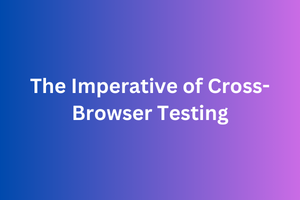Introduction:
In an era where users access the internet through a myriad of browsers and devices, the importance of cross-browser testing cannot be overstated. This blog post explores the compelling reasons why cross-browser testing is a crucial aspect of web development and how it contributes to ensuring a seamless and inclusive user experience.
Diverse Browser Landscape: The internet is not a one-browser-fits-all ecosystem. Users have varied preferences, ranging from Chrome and Firefox to Safari, Edge, and even the enduring Internet Explorer. Cross-browser testing ensures that a website or web application functions optimally across this diverse browser landscape, preventing the potential loss of users due to compatibility issues.
Browser Rendering Discrepancies: Different browsers interpret HTML, CSS, and JavaScript in distinct ways. This can lead to rendering discrepancies, where a webpage may look or behave differently depending on the browser. Cross-browser testing helps identify and address these variations, ensuring a consistent appearance and functionality across the board.
Version Compatibility: Browsers undergo frequent updates, each introducing new features and altering existing functionalities. Users may be using different browser versions, and it’s essential to ensure compatibility across this spectrum. Cross-browser testing allows developers to validate their websites against multiple browser versions, reducing the risk of issues arising due to outdated or unsupported features.
User Accessibility: Accessibility is a fundamental aspect of user experience. Users with disabilities may rely on specific browsers or assistive technologies. Cross-browser testing helps ensure that websites adhere to accessibility standards across different browsers, making the digital space more inclusive for all users.
Mobile and Responsive Design: With the increasing use of smartphones and tablets, web developers must ensure that their websites are responsive and function seamlessly on various screen sizes. Cross-browser testing extends to cross-device testing, allowing developers to verify the responsiveness of their websites across different devices.
Market Share Considerations: Browsers have different market shares in various regions and demographics. Cross-browser testing helps developers cater to a global audience by ensuring their websites perform well on the browsers that dominate specific markets.
Performance Consistency: Performance issues, such as slow loading times or laggy interactions, can vary across browsers. Cross-browser testing helps identify and optimize performance bottlenecks, providing users with a consistently smooth and efficient experience, regardless of their browser choice.
Conclusion:
In the competitive landscape of the internet, delivering a seamless user experience is non-negotiable. Cross-browser testing emerges as a strategic practice, safeguarding against compatibility issues that can tarnish a website’s reputation and drive users away. By embracing cross-browser testing, developers not only enhance the functionality and appearance of their websites but also contribute to a more inclusive digital environment where users can access content and services without hindrance, regardless of their choice of browser or device.




